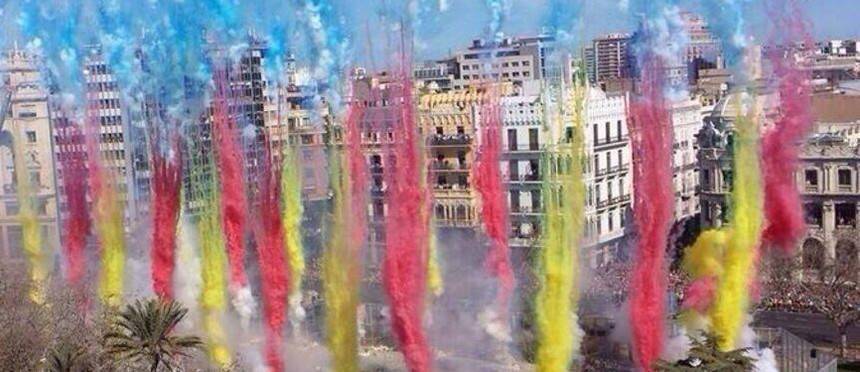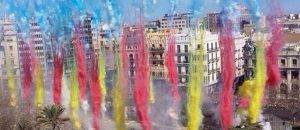By now, Valencia is plunged deep into the mid-March Mediterranean madness that is Las Fallas. The city streets are awash with brightly coloured streetlights, the smell of gunpowder from day time mascletas and night time fireworks pervades the air, women walk the streets in full fallera dress or regular clothes with their hair done up with the fallera hairpins. Oh yeah, and the streets are filled with about 370 of the monuments that gives Las Fallas its name, savouring their four days of 3-D life before their rendezvous with a fiery fate in the Cremá on the 19th.
By now, you’ve probably marvelled at their size and craftsmanship and something like “I can’t believe they burn them.” Maybe you’ve followed the wondrous spectacle of the plantá of a special section falla like Na Jordana, watching this 20+ meter-high creation take shape over days in the street, built from scratch by artists and carpenters whose skills astound you.
By now, you’ve probably absorbed some of the official history of the festival, hot it started about 150 years ago and turned into a homage to the patron saint of carpenters. How a few neighbours in the ‘hoods banded together to build satiric scenes in the streets and dragged out old furniture and trash for a little barrio bonfire action in the midnight hour of St. Joseph’s Day.
If you’re still new to Fallas, you’re probably still wandering around with your mouth open at the transformation of Valencia and cursing those pesky little firecrackers called petardos going off 24/7. But if you’re a veteran, you’ve probably also noted something else—year after year, too many fallas look alike.
The reasons are too complex to go into in detail here but a few islands of creativity exist in the Las Fallas sea. Probably the most consistent one is Na Jordana, where Manolo Martín has been the artist for the last three years.
Two years ago, Na Jordana’s falla featured the mushroom cloud of a nuclear explosion filled with fanciful animal mutations from the pen of Levante cartoonist Ortifus. Last year’s strikingly modern monument, designed by the Madrid artist Sigfrido Martín Begué, was dominated by a gigantic wooden Pinocchio. This year’s model finds Martín working with a new collaborator from outside the usual Fallas sphere, the Andalucian artist Chema Cobo.
“The idea this year is the same, to fill this space with another absolutely unique artist,” said Martín. “I believe it’s a traditional falla, a recuperation of something that hasn’t been done in fallas for years—the strong, hard social critique.
“It deals with the theme of the Spanish political transition from the death of Franco to our days. We’re trying to reflect on all the events, anec-dotes, and things that happened that stayed in the memory of Chemo Cobo and myself without resorting to going over the history again.”
Martín’s love for that part of fallas tradition that draws on often exaggerated humour, inside jokes and critical satire doesn’t extend to the aesthetic sphere, where he’s built a reputation for creative, innovative design since beginning his career in 1975. His work inspires strong pro and con reactions—in a Levante poll a few years ago, three of the four municipal fallas Martin built in the Plaza del Ayuntamiento during the mid-‘80s placed in the 10 best…and the same three showed up among the ten worst. But artistic limitations led him to put aside making fallas after 1988 and from the Trojan Horse collective to secure work for fallas artists outside the festival world— over 50% of the rides and décor at Terra Mítica are Trojan Horse works. But when Na Jordana came calling in 1999, Martín was ready to jump back in and pursue more creative collaborations to bring a broader diversity to Las Fallas.
“If you put Ortifus, Sigfried Martín Begué and Chema Cobo around a table, none of them have anything to do with each other (artistically) but all three are current,” he explains. “The beautiful thing for me would be that Las Fallas were more (artists) like Pepe Puche and Alfredo Ruiz, more people who don’t follow any kind of definite school or style except their own because it would give Las Fallas a variety that would enrich everything. The best thing for Las Fallas is if there are 300 distinct fallas, not 3 distinct ones and 297 that look the same.”
But don’t just stop by Na Jordana—that special section giant anchors a corner of the Carmen roughly stretching between the Torres de Serrano and the Torre de Quart that is home to a pretty concentrated zone of especially interesting fallas. Serranos/ Plazo de los Fueros, Blanquerías, Mosén Sorell/Corona (by the La Beneficiencia Museum), Quart-Palomar (home of Alfredo Ruiz) and Lepanto/ Guillermo de Castro usually boast monuments with a dis-tinctive creative touch that go beyond the same old, same old.
Don’t stop there, either—you should find some-thing to tickle your fancy in some of the traditional fallas, or the illuminated streets of Rusafa, or just walking the streets almost surrealistic post-Fallas void when Valencia wakes up on March 20th. Yes, the city will be a chaotic mess and traffic a nightmare—can you name a major city with a huge festival taking over the streets where that’s not the case?—but that’s no excuse for not enjoying the whole festive panorama that is Valencia in Fallas.
Altogringo
Related Post
This site uses Akismet to reduce spam. Learn how your comment data is processed.


























Leave a comment